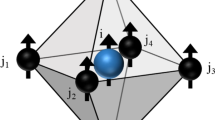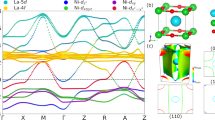Abstract
A spin subsystem of a nano-sized NdNi\(_8\) of a nickelate superconductor is chosen to calculate its contribution in controlling magnetic phase transition. The role of the spin distribution of NdNi\(_8\) in controlling magnetization (M) is studied within the framework of the mean field theory (MFT). Two different levels of perturbation in the exchange interaction between spins of Ni and Nd have been used. M (H, T) has been calculated numerically for perturbations of 0, 0.15 and 0.30 with respect to an unperturbed \(J_0\). Changes in M (H) in the range of T = 10.0–300.0 K have been found to be very sensitive to perturbation. Possibility of a magnetic phase transition has been found which is sensitive to the perturbation of the exchange integral. Sensitivity of the broadening of the phase transition is weaker for the level of perturbation in comparison with that for the magnetic field. Susceptibility is also calculated and analysed to understand how perturbed exchange integral affects magnetic phase transition in spin distribution of NdNi\(_8\).




Similar content being viewed by others
Data Availability Statement
This manuscript has associated data in a data repository. [Authors’ comment: The datasets generated during and analysed during the current study are available from the corresponding author on reasonable request.]
References
Z. Liu, Z. Ren, W. Zhu, Z. Wang, J. Yang, NPJ Quantum Mater 5, 31 (2020)
Q. Li, C. He, J. Si, X. Zhu, Y. Zhang, H.H. Wen, Commun. Mater. 1, 16 (2020)
M.Y. Choi, K.W. Lee, W.E. Pickett, Phys. Rev. B 101, 020503 (2020)
Y. Ji, J. Liu, L. Li, J. Appl. Phys. 130, 060901 (2021)
E. Been, W.-S. Lee, H.Y. Hwang, Y. Cui, J. Zaanen, T. Devereaux, B. Moritz, C. Jia, Phys. Rev. X 11, 011050 (2021)
K. Karl’ová, J. Strečka, M.L. Lyra, Phys. Rev. E 100, 042127 (2019)
S. Haldar, R.K. Saha, A.K. Ghosh, Phys. Lett. A 460, 128618 (2023)
R. Zhang, C. Lane, B. Singh, J. Nokelainen, B. Barbiellini, R.S. Markiewicz, A. Bansil, J. Sun, J. Phys. Commun. 4, 118 (2021)
X.M. Zhang, B. Li, J. Solid State Chem. 306, 122806 (2022)
S. Haldar, A.K. Ghosh, J. Supercond. and Nov. Magn. 33, 3217 (2020)
S. Haldar, A.K. Ghosh, J. Supercond. Nov. Magn. 34, 3217 (2021)
S. Haldar, R.K. Saha, A.K. Ghosh, Eur. Phys. J. Plus 136, 1099 (2021)
Y. Nomura, R. Arita, Rep. Prog. Phys. 85, 052501 (2022)
Y. Nomura, T. Nomoto, M. Hirayama, R. Arita, Phys. Rev. Res. 2, 043144 (2020)
R.C. Taylor, T.R. McGuire, J.M.D. Coey, J. Appl. Phys. 49, 2885 (2008)
H. Lin, D.J. Gawryluk, Y.M. Klein, S. Huangfu, E. Pomjakushina, F.V. Rohr, A. Schilling, New J. Phys. 24, 013022 (2022)
R.A. Ortiz, P. Puphal, M. Klett, F. Hotz, R.K. Kremer, H. Trepka, M. Hemmida, H.-A. Krug von Nidda, M. Isobe, R. Khasanov, H. Luetkens, P. Hansmann, B. Keimer, T. Schäfer, M. Hepting, Phys. Rev. Res. 4, 023093 (2022)
Acknowledgements
RKS acknowledges the University Grants Commission (UGC), Government of India, for the fellowship, and SH acknowledges the Department of Science and Technology (DST), Government of India, for the INSPIRE fellowship.
Author information
Authors and Affiliations
Corresponding author
Additional information
The original version of this article was revised to correct author name A. J. Ghosh to A. K. Ghosh in references 10, 11 and 12.
Appendix
Appendix
Mean value of a thermodynamic quantity (f) can be written with the help of the partition function as follows: \(\left<f\right>=\frac{{{\,\textrm{tr}\,}}{fe^{\beta {E}}}}{{{\,\textrm{tr}\,}}{e^{\beta {E}}}}\). Applying the MFT, we get \(\left<S\right>\) as
We have \({\mathcal {H}}_{eff}\) given as follows:
Now substituting \({\mathcal {H}}_{eff}\) values in Eq. (5), we obtain the following expressions for \(\left<S\right>\) :
Total average spin (\(\left<S\right>_{Tot}\)) is taken as,
Magnetization (M) of the system is, \( M = ng\mu _{\text {B}}\left<S\right>_{Tot}\)
\(n = N/V\), number of spins per unit volume, \(g=2\) and \( \mu _{\text {B}} = 9.27\times 10^{-24}\) J/T.
Susceptibility (\(\chi \)) has been calculated by the derivative of M(H).
We obtain \( \left<S\right>^{'} \), by taking the derivative with respect to H,
Substituting (8) and (9) in (7), we have an expression for the susceptibility as follows:
Rights and permissions
Springer Nature or its licensor (e.g. a society or other partner) holds exclusive rights to this article under a publishing agreement with the author(s) or other rightsholder(s); author self-archiving of the accepted manuscript version of this article is solely governed by the terms of such publishing agreement and applicable law.
About this article
Cite this article
Saha, R.K., Halder, S. & Ghosh, A.K. Perturbation of exchange interaction in Nd–Ni spin subsystem of nickelate. Eur. Phys. J. Plus 138, 247 (2023). https://doi.org/10.1140/epjp/s13360-023-03876-8
Received:
Accepted:
Published:
DOI: https://doi.org/10.1140/epjp/s13360-023-03876-8




